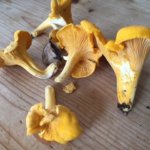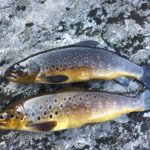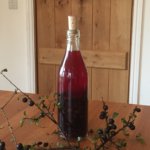The comment below was made following a previous post in this series:

‘……. with 7.6 billion humans on the planet, ‘wild food’ is either unsustainable, or a tiny niche irrelevant to almost everyone.’
It got me thinking and although it’s hard to disagree with the overall sentiment, I do take issue with the last part. It’s certainly not irrelevant to me. I would argue that the benefits are considerable although they are easy to underestimate. They could become more relevant to a sizeable and meaningful minority of people in Britain (as is already true in other parts of the world) with little risk of compromising sustainability.
For me, the main benefit is tricky to define or quantify though is no less important for that. It relates to the greater connection it brings with the local landscape. There is something remarkably life-affirming about the act of gathering and eating things that you have tracked down for yourself in the local countryside. It’s hard to put into words but it presumably stems from the hunter/gatherer instinct that is there, somewhere, in all of us. For obvious reasons it’s an extremely powerful instinct though it can take some re-finding in our frenetically-busy and detached modern world. At its most malign it results in driven grouse shooting but it can be used for good things too.
 This connection is similar to that resulting from watching (rather than eating) wildlife but it goes much deeper. You become more intensely aware of the gradual seasonal changes to habitats as different species rise in prominence and then fade from the scene for another year. A good autumn for Chanterelles is more memorable to me than, say, a good autumn for Red Admirals because it’s reinforced through the processes of searching, collecting and consuming. It’s hands on and it engages more of the senses – all of them in fact. It also pulls me back to the same places the following year, hoping for more of the same and helping me to appreciate year to year variations – and ponder the reasons behind them.
This connection is similar to that resulting from watching (rather than eating) wildlife but it goes much deeper. You become more intensely aware of the gradual seasonal changes to habitats as different species rise in prominence and then fade from the scene for another year. A good autumn for Chanterelles is more memorable to me than, say, a good autumn for Red Admirals because it’s reinforced through the processes of searching, collecting and consuming. It’s hands on and it engages more of the senses – all of them in fact. It also pulls me back to the same places the following year, hoping for more of the same and helping me to appreciate year to year variations – and ponder the reasons behind them.
 There are other benefits too, that are simply not accessible by any other means – at any price. Much as people who grow their own veg struggle with the taste of shop bought produce, the same can be true with wild food. Try replicating the taste of a Brown Trout caught earlier that day or Parasols gathered in their prime from a local grassland and on the plate within an hour. A trip to the supermarket won’t help. You can’t buy the Parasols and whilst you might find the trout it certainly won’t taste as good.
There are other benefits too, that are simply not accessible by any other means – at any price. Much as people who grow their own veg struggle with the taste of shop bought produce, the same can be true with wild food. Try replicating the taste of a Brown Trout caught earlier that day or Parasols gathered in their prime from a local grassland and on the plate within an hour. A trip to the supermarket won’t help. You can’t buy the Parasols and whilst you might find the trout it certainly won’t taste as good.
 There is a lot of wild food out there and a great deal more use could be made of it before there is any threat to its sustainability. It’s true that removing food from the countryside can have impacts on wildlife – some of them negative. After all, it is food for other things too. But for foraging to be a positive thing overall, the test is not whether there are no impacts, but whether the impacts are lower than the alternatives. These vary hugely but I’d be confident that local wild food comes out on the right side of the equation 99% of the time when compared with the closest supermarket equivalent. Anything gathered close to home or collected opportunistically when out and about doing other things has a food mileage of zero. In eating it, you are reducing consumption of shop-bought food with levels of sustainability that range from tolerable to ludicrous.
There is a lot of wild food out there and a great deal more use could be made of it before there is any threat to its sustainability. It’s true that removing food from the countryside can have impacts on wildlife – some of them negative. After all, it is food for other things too. But for foraging to be a positive thing overall, the test is not whether there are no impacts, but whether the impacts are lower than the alternatives. These vary hugely but I’d be confident that local wild food comes out on the right side of the equation 99% of the time when compared with the closest supermarket equivalent. Anything gathered close to home or collected opportunistically when out and about doing other things has a food mileage of zero. In eating it, you are reducing consumption of shop-bought food with levels of sustainability that range from tolerable to ludicrous.
 Of course, as with any environmental cause (if that’s what this is), the actions of any one individual make only a tiny difference to the way the world works. But they do make a difference and if you can persuade a few others to join you that helps all the more. At the same time, you will be helping to increase the pool of staunch defenders of the local environment. Losing a place where you enjoy seeing Redwings and Fieldfares in the winter is one thing but if that same site provides what you need for your annual batch of sloe gin, its loss will be altogether more alarming.
Of course, as with any environmental cause (if that’s what this is), the actions of any one individual make only a tiny difference to the way the world works. But they do make a difference and if you can persuade a few others to join you that helps all the more. At the same time, you will be helping to increase the pool of staunch defenders of the local environment. Losing a place where you enjoy seeing Redwings and Fieldfares in the winter is one thing but if that same site provides what you need for your annual batch of sloe gin, its loss will be altogether more alarming.
I was very taken by something George Monbiot wrote recently about the benefits of trying to act positively rather than giving up in despair (in respect of climate change but the same applies here). Why should individuals even bother trying to minimise their impacts when global behaviour patterns mean we will inevitably lose much of what we hold dear? Well, if all we can do is help to ‘draw out the losses over as long a period as possible, in order to allow our children and grandchildren to experience something of the wonder and delight in the natural world……….. Is that not a worthy aim, even if there were no other?’
Wild food can help with that, in a small, but nevertheless worthwhile, way.
[registration_form]
One of my greatest views of live was seeing folk in suits getting on a train to go to work in Warsaw while folk were getting off the train with baskets to go and pick mushrooms in the woods! Which one would you rather be!!!!
John – In similar vein, I’ve been watching Ben Fogle’s ‘Lives in the wild’ programme recently. For some reason I always imagine the people he stays with are going to be total nutters (and there have been a few) but, by and large, they come across as completely sane and thoroughly content with their lot. You end up thinking that they’ve got it spot on and its the rest of us that are the nutters.
Biodiversity and abundance is depleted in Britain because we’ve turned the island into a food factory to feed the enormous human population. Could we not,should we not, spare the remnants of wildness and enjoy them without eating them?
Phil – You don’t really say why you have a problem with it. I agree we should ‘spare’ the species involved in that we shouldn’t misuse them or exploit them unsustainably. But making some use of them whilst at the same time not encouraging any further intensification of the food factory makes good sense to me.
I tend to agree with Ian on this one over the years i’ve eaten or otherwise used a variety of fungi, all the usual wild fruits, blackberries, raspberries, bilberries, cowberries elderberries, cloudberries and Damsons gone wild. Various wildfowl including Mallard, Teal, Canada and Greylag Goose. also Brown, Sea and Brook Trout, Grayling ( the best of freshwater fish by far), Eel, Rabbit, Brown Hare and the pseudo wild Pheasant, (frequently and often not shot!) I would not expect us all to do it but in moderation without damaging the wild populations I do not see a problem. It is true something grown, gathered or otherwise garnered by your own hand satisfies the senses and nearly always tastes better too!
With respect to your last comment about giving up in despair with respect to climate change, I have a different view. The recent BTO report titled: “Projected reductions in climatic suitability for vulnerable British birds” says that the climate is improving for 44% of British birds, it is getting worse for 9%, and so one might infer it does not make a whole lot of difference for 47%.
It could more appropriately have been titled:
“Climate change is good news for most British birds”
People picking a few berries and mushrooms is nothing, in terms of environmental damage to the thousands of hectares of rainforest cut down for biofuels, or the thousands of hectares of land used to grow maize for fuel production, rather than food.
Let’s face it, climate change so far has produced a net environmental benefit: e.g. the greening of the planet – 15% more plant growth. The policies invoked to try and prevent it are mostly environmentally disastrous, and, so far, have produced results that cannot now, nor in the future produce measurable results, despite the expenditure of trillions of dollars. Just as important is the huge distraction from the real problems facing the planet.
Dick, we are straying off the topic of Ian’s blog somewhat but I think he’ll understand! More plant growth via increasing CO2 levels is not completely beneficial to our planet and feeding people. https://www.theguardian.com/environment/2014/may/07/climate-change-food-crops-nutrition
Thank you for the link Stella, I didn’t know that. But, as increased Co2 has caused total crop production to go up by more than the reduction in % nutrients, it is still a net gain.
All I am trying to do is highlight that, it is not all bad news.
This facet of nutrient density resurfaced again recently, hilariously as a breathless article in Politico, that leading Crop Physiology and Nutrition journal. Raised CO2 levels under glass have been used since at least the 1960s to produce taste-free tomatoes and other crops, so confirmation that relative mineral content is decreased under CO2 fertilisation is interesting, but hardly unexpected. In the UK, mostly under the influences of plant breeding and agronomy, wheat yield has increased from 3.5 to 8.6t/ha since 1960, but without prominent focus on minor element fertilisation other than by avoidance of pH-induced unavailabilities. Beyond that, this aspect of food quality isn’t seen as critical where people have access to diverse diets.
You would think that desert greening on the scale of adding a new Continent’s-worth of vegetation would be welcomed, but as it doesn’t fit the narrative, it won’t.
Ian, I think it is time you catered for the urban naturalist and produced a discourse on the delights of Fray Bentos pies!
Alistair- I feel like I’ve been outed! Sprinkle a few chanterelles on top and call it wild food? I will definitely get on to a few urban options…